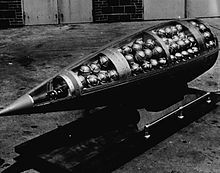
Back Trosbom Afrikaans قنبلة عنقودية Arabic Bomba de recímanu AST Kasset bombası Azerbaijani Касетны боепрыпас Byelorussian Касетъчни боеприпаси Bulgarian ক্লাস্টার বোমা Bengali/Bangla Bomba de dispersió Catalan بۆمبی ھێشوویی CKB Kazetová puma Czech



A cluster munition is a form of air-dropped or ground-launched explosive weapon that releases or ejects smaller submunitions. Commonly, this is a cluster bomb that ejects explosive bomblets that are designed to kill personnel and destroy vehicles. Other cluster munitions are designed to destroy runways or electric power transmission lines.
Because cluster bombs release many small bomblets over a wide area, they pose risks to civilians both during attacks and afterwards. Unexploded bomblets can kill or maim civilians and/or unintended targets long after a conflict has ended, and are costly to locate and remove. This failure rate ranges from 2 percent to 40 percent or more.
Cluster munitions are prohibited for those nations that ratified the Convention on Cluster Munitions, adopted in Dublin, Ireland, in May 2008. The Convention entered into force and became binding international law upon ratifying states on 1 August 2010, six months after being ratified by 30 states.[1] As of 10 February 2022, a total of 123 states have joined the Convention, as 110 states parties and 13 signatories.[2]
- ^ "Treaty status – The Treaty – CMC". www.stopclustermunitions.org. Retrieved 15 May 2018.
- ^ "Convention on Cluster Munition Website". The Convention on Cluster Munition. Geneva (Switzerland). February 10, 2022. Archived from the original on 2008-06-12. Retrieved March 1, 2022.